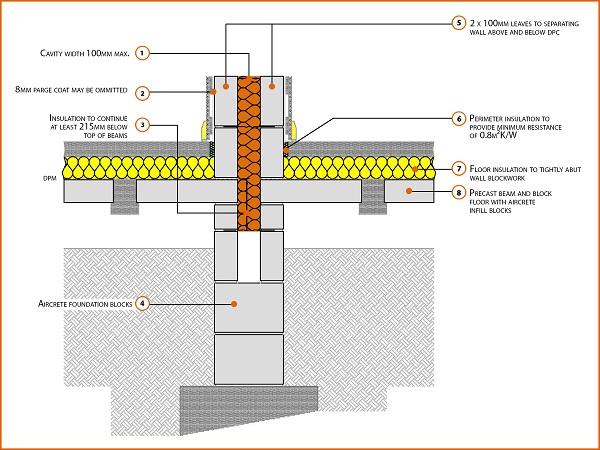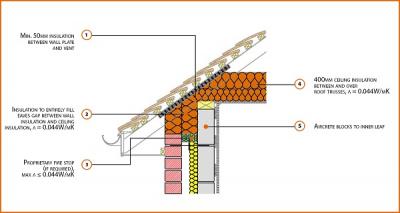Registered Construction Detail 1 - Party Wall Junction
P1 Party Wall Junction at Floor Level P1PCFF1
This is a complicated junction because not only are thermal considerations needed, but also those of sound insulation and fire resistance. Insulation must be fitted tightly to the floor junction, so consider using full sheets against the perimeter and party wall with offcuts positioned in the centre of the slab.
Insulation together with membranes effectively isolate the floor from the party walls for impact sound, but the perimeter insulation isolating the screed needs to have a minimum thermal resistance of 0.8Wm2K/W and the party wall insulation needs to have a lambda value of at least 0.044W/mK but a density no greater than 40kg/m3 and is suitable for use below dpc level as it needs to extend 215mm below the top of the floor beams. It is therefore vital to ensure your insulation choices can satisfy these criteria.
The Detail also offers other choices of floor block type and thicknesses of floor insulation beneath the screed. This junction is in relation to the horizontal plane and the corresponding vertical junction to the same Detail is Party wall between dwellings.
Why is thermal bridging so important?
- Registered Construction Details can enable an otherwise failing building to pass with no alteration to insulation levels or use of triple glazing or expensive renewable technologies.
- Cost analysis shows savings as much as £1,200 on a 90m2 unit through correct specification and attention to detail.
Talk to your architect, designer or specifier about this, they can speak to the SAP assessor who can start designing out unnecessary costs. Find out more here.
About Registered Construction Details (RCDs)
Our Registered Construction Details provide free detailed drawings of thermal bridge junctions together with points to watch, specification and thermal properties of the key materials. They contain everything that’s needed to get the job right.
Sign up to the building bulletin newsletter
Over 48,000 construction professionals have already signed up for the LABC Building Bulletin.
Join them and receive useful tips, practical technical information and industry news by email once every 6 weeks.
Subscribe to the Building Bulletin




Comments
Party Wall - neighbours burnt toast
Submitted 3 years 10 months ago
Reply
Submitted 3 years 9 months ago
Thanks for getting in touch with LABC.
Your query is certainly unusual. I think everyone can conjure up the smell of bread in the toaster, but I’ve never really considered Weetabix to have a particular smell.
It is very strange for you to be able to smell toast (and certainly Weetabix) from your neighbour’s property. If adjacent windows were open and a prevailing wind was to blow the hot air into your property, that might explain it. However, if all windows are closed and the window seals are functioning properly, then the smell appears to somehow be permeating through the structure, which seems extremely unlikely, unless there is a breach in your party wall.
If this is a new property, I presume you have contacted the developer? If not, that would be the best first option – to see if they are able to identify where the smell appears to be originating from. If there is a breach in the party wall this requires attention, since it poses a fire risk and I’m sure the developer would be keen to sort this issue.
If there are no obvious gaps and the developer is unable to help further, then perhaps a call to your local council’s environmental health section and seek their opinion.
Sorry I cannot be of more help in this instance.
Kind regards
Richard, LABC
Add new comment